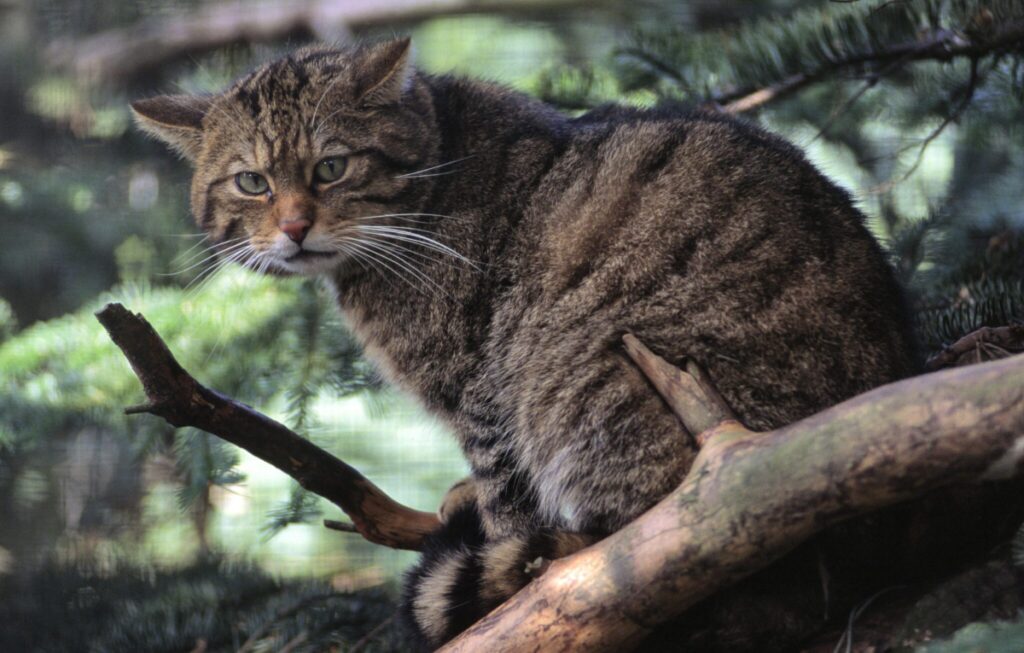RESEARCH published today by NatureScot is being used to inform people about the action that is needed to secure the Scottish wildcat’s long-term future.
To establish a sustainable population of wildcats the research recommends a number of actions, to work alongside releases of wildcats, for population reinforcement.
These include reducing the threat of hybridisation with domestic cats and hybrids, improving the habitats wildcats use, and reducing deaths from disease, persecution and road traffic accidents.

Funded by the National Lottery Heritage Fund, the suite of nine technical reports and a summary report presents all of the work completed by Scottish Wildcat Action, a multi-partner project led by NatureScot, which ran from 2015-2020.
Over the five-year lifespan of the project, Scottish Wildcat Action:
- Worked with over 140 volunteers to detect, trap, neuter and vaccinate 205 feral domestic and obvious hybrid cats.
- Collected over one million images in camera-trap surveys of wild-living cats, identifying 356 cats in six priority areas and collected 769 cat records from the public.
- In addition to exhaustive camera trap surveys in the six priority areas, project partners conducted camera-trap surveys at 268 camera locations in over 30 sites stretching from Torridon to the Trossachs.
- Ran genetic tests on 529 cat samples, finding that no samples taken from wild-living cats scored highly enough to be considered wildcats.
- Examined the morphology of 118 dead cats, over half of which were killed on our roads, with none proving to be wildcats.
- Genetically screened all fertile captive wildcats in the Scottish Wildcat Studbook, managed by the Royal Zoological Society of Scotland, and increased the captive wildcat breeding population by 67% in preparation to establish a conservation breeding programme.
- Tracked, using GPS collars, 14 wildcat hybrids to identify potential threats to wildcats and learn more about their ecology and behaviour.
The project was able to show that there were too few wildcats for their populations to be sustainable in the short or long term.
In 2019 Scottish Wildcat Action shared its evidence with the IUCN SSC (International Union for the Conservation of Nature, Species Survival Commission) Cat Specialist Group, who concluded in their own independent review that the wild population was no longer viable without reinforcement or reintroduction.
Scottish Wildcat Action’s work has been used to inform the design of a next phase of work, Saving Wildcats, led by the Royal Zoological Society of Scotland (RZSS) in collaboration with NatureScot, Forestry and Land Scotland, Cairngorms National Park Authority, Nordens Ark and Junta de Andalucía, with releases conducted with the support of Cairngorms Connect.
Saving Wildcats aims to prevent the extinction of wildcats in Scotland by breeding and releasing them into the wild and is supported by the LIFE programme of the European Union.
The team are currently preparing for the first in a series of trial releases of wildcats in the Cairngorms National Park this summer.
Biodiversity Minister Lorna Slater said: “The Scottish wildcat is an iconic and much loved native species, and yet its very existence is under threat.
“This research from Scottish Wildcat Action will be critical in informing future decisions on how we can revive numbers throughout the country and safeguard the population in the future.
“Reversing the dramatic losses in nature that we have seen in recent times is one of the defining challenges that our country faces.
The Scottish Government remains committed to this fight and is actively working towards protecting and restoring our natural environment.”
Dr Roo Campbell, NatureScot’s Mammal Adviser and report author, said: “The Saving Wildcats project represents a vital phase in restoring the wildcat in Scotland, but this is not the final step on the journey, we’re still at the beginning.
“To succeed, wildcat conservation in Scotland next needs a nationwide effort with long-term commitments from all stakeholders over the coming decades.
“Improvements to habitats and reduction in risks, such as those from land management practices, will help ensure future wildcat populations remain viable. But a key part of this will also be removing the threat of hybridisation.
“This includes continuing efforts to neuter pet domestic cats, feral domestic cats and obvious hybrids.
“This report highlights that changes to legislation to ensure pets are microchipped and neutered would also significantly reduce this threat, and so we would like to work with stakeholders to see what can be achieved to help save the wildcat.
“The ultimate goal must be to establish a population of wildcats that does not need further human intervention to secure its survival. We’re hopeful that we can achieve this by working together now to protect and restore this iconic species for generations to come.”

